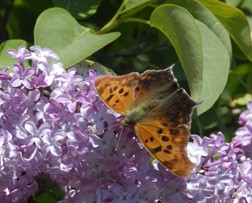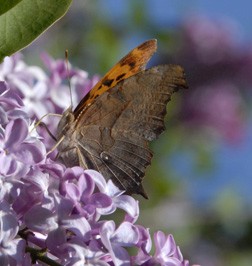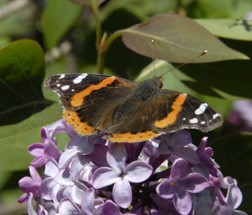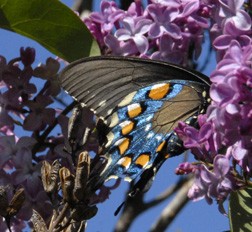A Butterfly Bonanza
- Share
- Tweet
- Pin
- Share

The bright orange wings of the Question Mark Butterfly are easily seen.
This past May will surely go down in our journals and phenology notes as an excellent month for butterflies. The extremely early warm stretch of weather brought the Monarchs to our area nearly three weeks sooner than in past years. Our perennial Swamp Milkweed was already sending up about a half dozen shoots six or seven inches high by Mother’s Day with only an inch or so of young green leaves showing. Much to our surprise a female Monarch laid five eggs on the foliage right before our eyes. Yes, all hatched about 10 days later.
Much to our great delight we observed more Monarchs on Tuesday, May 15 than we saw all last summer. This was especially encouraging news in light of the terrible report being distributed by butterfly experts “in the know” that these amazing migratory butterflies suffered a very bad winter in Mexico and that their numbers continue to plummet.
Our good friend, Nick Anderson, who volunteers as a docent at the Toft Point State Natural Area on Thursday mornings, called at noon, May 24, to report huge concentrations of butterflies feasting on the nectar of the large lilac shrubs near the site of the old main lodge. Out I went armed with camera ready for action. You can imagine my amazement at finding what I estimated to be as many as 100 butterflies at one moment. The circular cluster of old lilacs must be at least 15 feet in diameter.

Note the silvery question mark on the rear wing undersurface of the Question Mark.
The very strong whippy wind immediately ruled out using a tripod with the camera. Instead, I chose to use my hand-held SLR camera with an 18-200 mm macro lens. To compensate for the wind, I set my shutter at 1/320th of a second, and the ISO at 500, providing me with adequate depth of field for the small butterflies. It was a simple matter on this brilliant sunny day to patiently wait for a brief calm period when the wind momentarily slowed and then to “pop” one picture after another, hoping that at least a few would be sharp.
The four most abundant species listed in order of numbers observed were: Question Mark, Red Admiral, American Lady and the Monarch. Of the 10 species observed that day, the remaining kinds enjoyed were: Mourning Cloak, Eastern Tiger Swallowtail, Black Swallowtail, Buckeye, Clouded Sulphur, and Mustard White. My butterfly-expert friend, Dick Smythe, agreed with me saying that this has been an extraordinarily excellent flight year so far for the so-called “Anglewings,” which for Door County include, among others, the more commonly seen Question Mark and Comma.
Another surprise turned out to be a Snowberry Clearwing Moth, also feasting on the nectar of the lilac flowers. Also referred to as the Bumblebee Moth, this fascinating creature having rather long clubby antennae sports largely translucent wings with black veins and narrow black borders. Another translucent-winged moth, but lacking the black veins, common to Door County is the Hummingbird Clearwing also lured to flower nectar.
It was the numerous Question Mark Butterflies that took front and center stage for me. Once a specimen found a sunny spot somewhat out of the wind, and blossoms filled with nectar, it became so focused on feasting and so trusting that one could nearly touch it. I love this butterfly’s species name, interrogationis. A close look at the central area of each of the undersides of the rear wings reveals a silver curved line and a dot somewhat resembling a question mark. Its close and smaller relative, the Comma Butterfly, has only a silver curved line on the undersides of each of its rear wings.

The brilliant upper wing surface of a Red Admiral Butterfly.
The Question Mark is one of the largest of the Anglewings. It has longer “tails” on its rear wings than the Comma, and eye-catching bright reddish upper wing color making it very easy to identify in the field. A very lovely, thin, delicate hue of violet-gray decorates the edges of especially the rear wings. One summer this beautiful butterfly may be abundant, the following year few in number. Bear in mind that, just like most living creatures, humans included, there can be considerable variation of color and even size with this butterfly.
The Question Mark is a double-brooded species having winter and summer forms. Right now we are seeing the winter form that begins in later April and runs through the end of May. These have either spent the winter here in the county hibernating as adults, or had migrated to a more southerly and warmer location last year for the winter and are now returning northward. They will mate and die, with the summer form eclosing (leaving the chrysalids as adults) throughout July, August and into late September.

The dazzling rear wing undersurface of a dark female Tiger Swallowtail Butterfly.
The winter form we are now seeing is considerably lighter on both upper and lower wing surfaces than the summer form that we’ll begin observing in July. The summer form you’ll enjoy will have very dark brown-to-black upper surfaces on its rear wings while the undersides of both wings will be more brownish and have some dark banding.
The female Question Marks have most likely laid their eggs on one of the host plants including American Elm, Stinging or Woodland Nettles, and Basswood. The adult food of both winter and summer forms will include the nectar of flowers and especially tree sap, rotten fruit, dung and carrion.
Few creatures are as gentle, harmless, common and beautiful as butterflies. They don’t chase after you, bite or sting you and they cannot transmit diseases. In my opinion we would all be much better off if we slowed down, lived more simply and studied and enjoyed the butterflies every summer in addition to other wonderful facets of nature. And remember, butterflies are light and delicate but are powerful reminders of how fragile our planet Earth is!


